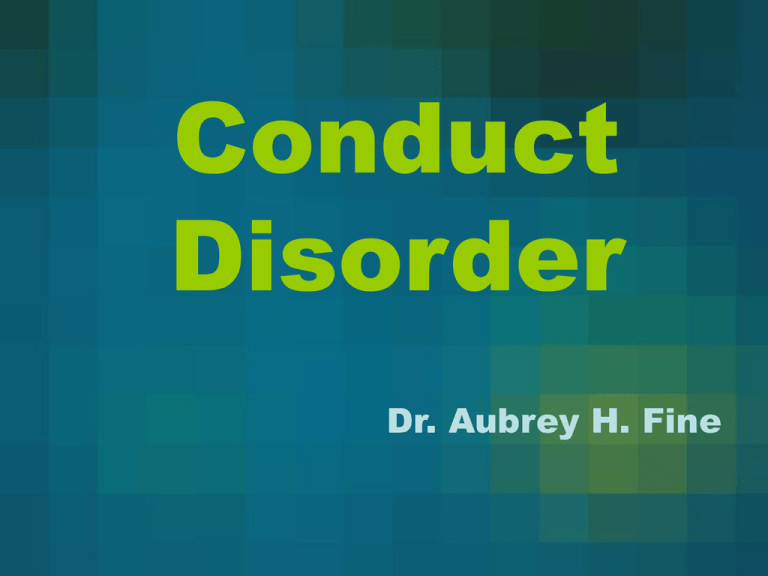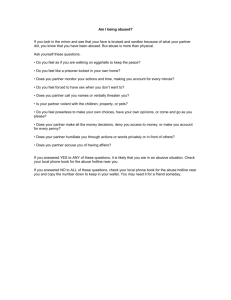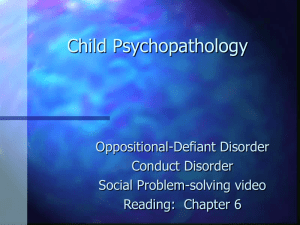Conduct Disorder
advertisement

Conduct Disorder Dr. Aubrey H. Fine Overt Aggression How is Overt Conduct Disorder Identified and Treated? Conduct Disorder • Characterized by persistent antisocial behavior that violates: – The rights of others – Age-appropriate social norms • Includes: – Aggression to people and animals – Destruction of property – Deceitfulness and theft – Violation of rules Students with Conduct Disorder • Differ from peers in – Rate of noxious behaviors – Persistence of such conduct beyond age at which most children have adopted less aggressive behaviors How Do These Students Do in School? • Teachers see these students as: – Uninterested – Unenthusiastic – Careless • Students with Conduct Disorder have: – Poor interpersonal relations – Rejected by their peers – Poor social skills • Students with Conduct Disorder are most likely to be: – Left behind in grades – Show lower achievement levels – End school sooner than same-age peers The Vile Weed: Stages in the Coercion Model Conduct Disorder Case Study • Tony is 13 and has conduct disorder and depression. He is living with his Uncle and Aunt who have basically raised him since birth. Occasionally his mom comes by, but not on a regular basis. The father is unknown. Tony’s Uncle and Aunt adopted him. They are the head of a “team” which cares for Tony. This includes respite foster parent’s two weekends a month, Tony’s other Uncle one weekend a month, and his grandparents or his adopted parents the other weekend. At the moment, Tony is doing well. After the last sentencing, they were able to get better cooperation from their probation officer and a more workable probation agreement. Tony is supervised more than his adopted parent’s four year old. Last year he was hospitalized after he cut his wrist when he was caught drinking. Tony is now part of a group at school who are putting together a house. For once he is doing really well, expect when he tried to steal an electric saw. But Tony’s parents had warned the school to watch for this, and they did, and they caught him. The punishment? No electric guitar for four days. Every week or so while Tony is at school, his parents go through all his stuff. They have told Tony they will do this. Tony now thinks it is mean and unfair. On the other hand, their have been no knives in the house for a month now. His parents call it “room service”. Conduct Disorder • Is often comorbid with other disorders • Is one of the most prevalent psychopathological disorders • Affects: – 6 – 16% of males – 2 – 9% of females – 1.3 to 3.8 million children have conduct disorder Conduct Disorder • Males exhibit: – Fighting – Stealing – Vandalism • Overly aggressive • Females exhibit: – Lying – Truancy – Running away – Substance abuse – Prostitution • Less aggressive Conduct Disorder • May be classified by age of onset • Earlier onset usually predicts more serious impairment The Causal Wheel Classified As: • Mild (resulting in only minor harm to others) • Moderate • Severe (causing considerable harm to others) • Undersocialized (violent behavior) • Socialized (more covert antisocial acts) – Versatile (both overt and covert forms of antisocial conduct) Conduct Disorder • Subtypes –Overt Aggression –Covert Antisocial –Versatile Causes of Aggression • Learned through: – Modeling – Reinforcement – Ineffective punishment • Risk can be increased through these factors: – Personal – Family – School – Peer – Cultural Preventing Aggression • Consequences that deter aggression • Instruction in nonaggressive responses • Early intervention • Restriction of tools of aggression • Correction of living conditions • More effective school options Assessing Aggression • Behavior rating scales, AND • Direct observation • Must include: – Evaluation of a variety of domains – Prosocial skills – Social deficits – Functional assessment of behavior Interventions for Aggression • Interventions based on social learning – Most reliable – Include strategies such as: • • • • • • • Rules Teacher praise Positive reinforcement Verbal feedback Stimulus change Contingency contracts Modeling and reinforcement Uses and Misuses of Punishment • Punishment should: – Be reserved for serious misbehavior – Be instituted in ongoing behavioral management and instructional programs – Be used only by people who are warm and loving toward the individual – Be administered matter-of-factly, without anger, threats, or moralizing – Be fair, consistent, and immediate – Be of reasonable intensity – Involve response cost – Be related to the misbehavior – Be discontinued if it is not quickly apparent that it is effective – Have written guidelines for using specific punishment procedures Behavior Cycle and Precorrection 1) Calm: Behaving in ways that are expected and appropriate 2) Trigger: First stage in moving towards a major blowup 3) Agitation: Overall behavior in unfocused and off task 4) Acceleration: Student engages the teacher in a coercive struggle 5) Peak: Student’s behavior is out of control 6) De-escalation: Student is beginning to disengage from the struggle and is in a confused state 7) Recovery: Eager for busy work and a semblance of ordinary glasswork The Acting Out Cycle School-Wide Discipline • School-wide discipline plans must: – Focus on earlier phases in the acting out cycle – Focus efforts on positive attention to appropriate behavior – Provide clear expectations and monitoring of student behavior – Provide staff communication and support – Provide consistent consequences Covert Aggression How is Covert Conduct Disorder Identified and Treated? Definition • Covert Antisocial Behavior includes: – Untrustworthiness and manipulation of others; – Running away; and – Concealment of one’s acts. • “Masculine” Antisocial Behaviors – Vandalism, fighting, and stealing. • “Feminine” Antisocial Behaviors – Lying, running away, and substance abuse. • Behaviors Clustered Together for Males and Females – Truancy, expulsion, underachievement, and discipline Casual Factors and Prevention Assessment • Covert behaviors are difficult to observe • Involves: – Long periods of observation – Self reports Definitions of Animal Abuse • Social Science: Socially unacceptable behavior intentionally causes unnecessary pain, suffering, distress, or death. Law: Unnecessarily overloads, overdrives, torments, deprives of necessary sustenance or shelter, or unnecessarily mutilates, or kills any animal (misdemeanor); intentionally Types of Animal Abuse •Neglect - no satisfaction derived; due to carelessness, callousness and ignorance • Abuse - satisfaction derived from dominance or from behavioral response •Sadistic- takes satisfaction from suffering •Hoarding •Sexual abuse: crush videos •Subcultural abuse: socially acceptable Animal Abuse and Adult Criminality •MSPCA Study: 1975-1996 —80,000 complaints —268 efforts to prosecute —119 convictions —91 fined —28 served time (average of 4.5 months) •Compared to “next door neighbors,” men prosecuted for animal abuse were • 5 X more likely to commit violent crimes • 4 X more likely to commit property crime • 3 X more likely to have record for drug or disorderly conduct offense Adult Criminality and Childhood Animal Abuse •Alan Felthous and Stephen Kellert Studies—Compared criminals to non-criminals and psychiatric to “normal” —Significant association between acts of cruelty to animals in childhood and serious, recurrent aggression against people as an adult; most aggressive criminals committed more severe acts of animal cruelty •Frank Ascione —48% of individuals incarcerated for sexual homicide abused animals as children —46% of convicted rapists abused animals as children Child Abuse and Animal Abuse •New Jersey Study - 53 families met criteria for child abuse or neglect. 60% had confirmed instances of cruelty to animals; in families referred for physical abuse, 88% had instances of animal abuse: 2/3 by fathers; 1/3 by children. •1980 study in England: Of 23 families with history of animal abuse, 83% had children at risk for abuse or neglect. •Pennsylvania study corroborated that behavior patterns toward children and pets are similar. Abused Children Abuse Animals • In one study, 4.7% of “normal” children acknowledged animal abuse, compared to 13% who were sexually abused 24.5% who were physically abused 34% who were both physically and sexually abused • Children who witness violence are at greater risk of becoming abusers or victims • 26% to 32% of children in abusive families cruel to animals Responses • Primary Prevention – Humane education • Secondary Prevention – Programs for at-risk children • Tertiary Prevention – The AniCare Model of Treatment for Animal Abuse – AniCare Child Programs—Pairing At-Risk Children and Families with Animals in Need •“Forget Me Not Farm,” collaboration of Humane Society of Sonoma County, the San Francisco Child Abuse Council, and the YWCA of Sonoma County, which includes the Women’s Emergency Shelter and a therapeutic child care services program. Teaching gentleness with gardens and animals to children from violent homes and communities. – Safe Haven for Pets Programs • Various arrangements, depending on local community • Local vets provide shelter and medical care • Fostering • AniCare Child Practical, concrete tools for assessment, prevention, and intervention • Designed for all professionals working with children--counselors, teachers, social service workers, probation department officials, clergy • Focuses on empathy development and self management skills • Includes case studies, projective materials, and individual and group exercises The AniCare Model of Treatment for Animal Abuse • Stresses accountability and empathy development • Cognitive-behavioral • Active therapist, directly addresses problem • Pre- and Post-Treatment Questionnaires • Ten AniCare Exercises, with homework – – – – Becoming the Victim Fostering Flexibility Learning to Nurture Establishing Intergenerational Accountability Responding to Stealing • • • • • • Define stealing Parents decide when theft has occurred Parents apply consequences Every instance of stealing receives consequences Parents “keep eyes open” and ask questions Consequences involve specified interval of work or period of restriction • No positive reinforcement for periods of nonstealing • Program remains in effect for at least 6 months Responding to Lying • Careful monitoring of verbal and written products • Providing reinforcement for honest behavior • Punishing occurrences of lying • Determining if child can differentiate truth from non-truth • Avoiding getting caught up in arguments about the veracity of statements Firesetting • Children may be more likely to set fires if: – They do not understand the danger of fire – They do not have the necessary social skills to obtain gratification in other ways – They engage in other antisocial behaviors – They are motivated by anger and revenge Vandalism • Appears to be a reaction to aversive environments: – Vague rules – Punitive discipline – Rigid punishment – School curriculum not matched with student needs – Little recognition for appropriate behavior or achievement Responding to Truancy • Social Learning Principles – Attendance is praised – Systems where attendance earns rewards – School work that is interesting – Connecting school and home – Stopping harassment by peers – Decreasing fun outside of school during school hours Problem Behaviors of Adolescence How are problem behaviors identified and treated in adolescence? Juvenile Delinquency • Delinquent acts • Index crimes • Status offenses Types of Delinquents • Those who commit a few delinquent acts vs. repeat offenders • Age at first offense – Prognosis is worse for juveniles who offend before the age of 12 Causes of Delinquency • • • • • • • History of child abuse Hyperactivity and impulsivity Low intelligence and achievement Lax parental supervision Family history of criminality Poverty and large family size Antisocial behavior or conduct disorder Causes of Delinquency Responding to Delinquency • Families – Intervention is extremely difficult • Juvenile Courts and Correction – Harsher punishments seem counterproductive • Schooling – Typical punishment is usually ineffective Street Gangs • The typical gang member has: – A notable set of personal deficiencies – A notable tendency toward defiance – A greater-than-normal desire for status, identity, and companionship – A boring, uninvolved lifestyle Substance Abuse • Usually episodic for most adolescents • Alcohol and tobacco are the largest problems • Important Terms – Intoxication • Symptoms of a toxic amount of substance in the blood stream – Tolerance • Physiological adoption to a substance so that an increasing amount is required to produce the same effects – Addiction • Compulsive use of a substance and that obtaining and using the substance has become a central concern and pattern of behavior – Dependence • The need to continue using a substance to avoid physical or emotional discomfort or both – Withdrawal • Physical or emotional discomfort associated with a period of abstinence Preventing Substance Abuse • Must be designed for the individual case • School based interventions must: – Require clear school policies – Require systematic efforts to provide information – Provide referral to other agencies – Involve families and peers Preventing Substance Abuse – con’t • Skills for students to learn: – Resist peer pressure – Change attitudes, values, and behavioral norms related to substance use – Recognize and resist adult influences toward substance use – Use problem-solving strategies such as selfcontrol, stress management, and appropriate assertiveness – Set goals and improve self-esteem – Communicate more effectively Seven Possible Symptoms of Drug Involvement 1) Change in school or work attendance or performance 2) Alteration of personal appearance 3) Mood swings or attitude changes 4) Withdrawal from responsibilities / family contacts 5) Association with drug-using peers 6) Unusual patterns of behavior 7) Defensive attitude concerning drugs Early Sexual Activity • Increases: – Risk of pregnancy – Sexually transmitted diseases – Psychological and health problems • Current school based interventions may be ineffective





